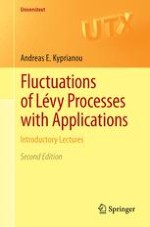2014 | OriginalPaper | Chapter
12. Continuous-State Branching Processes
Author : Andreas E. Kyprianou
Published in: Fluctuations of Lévy Processes with Applications
Publisher: Springer Berlin Heidelberg
Activate our intelligent search to find suitable subject content or patents.
Select sections of text to find matching patents with Artificial Intelligence. powered by
Select sections of text to find additional relevant content using AI-assisted search. powered by
